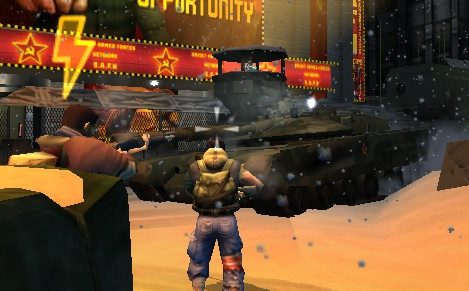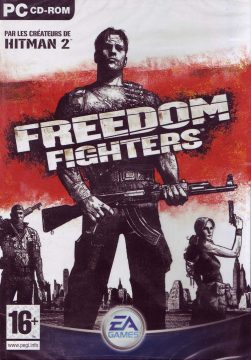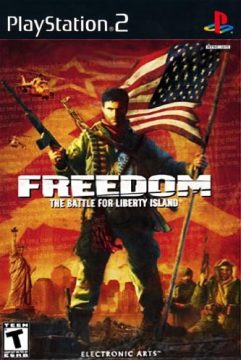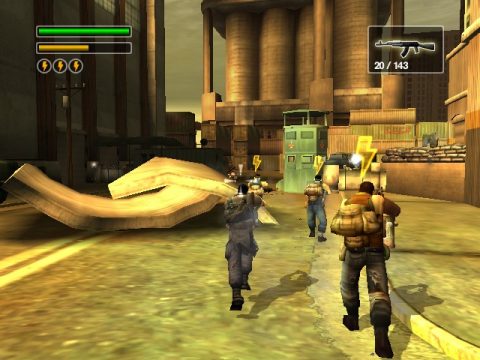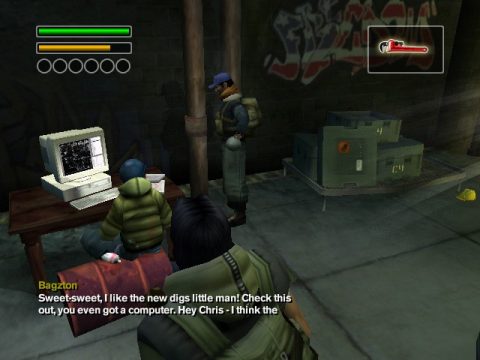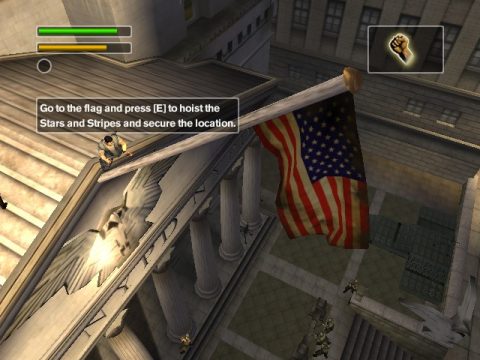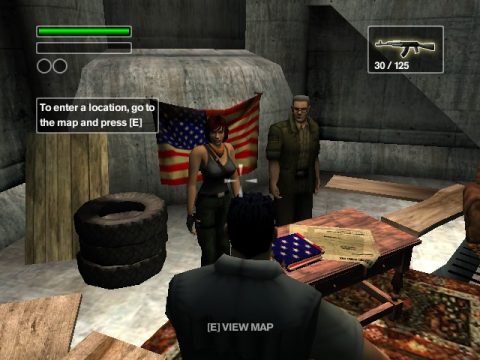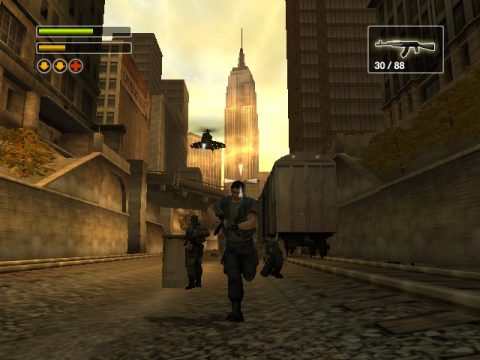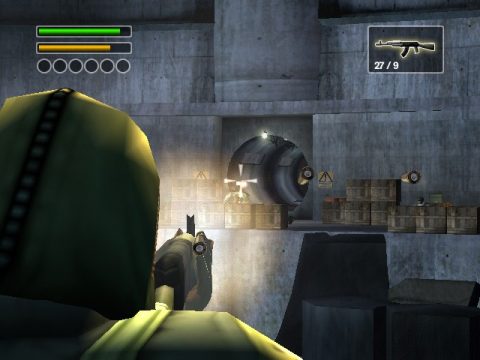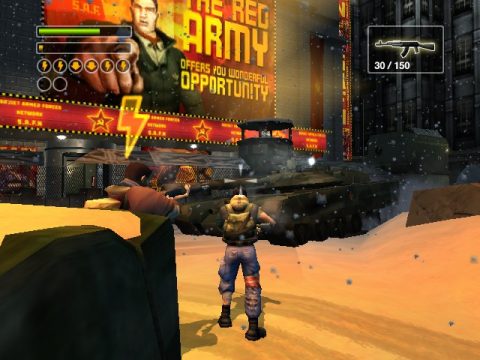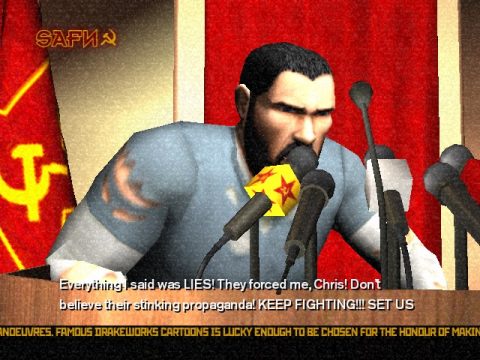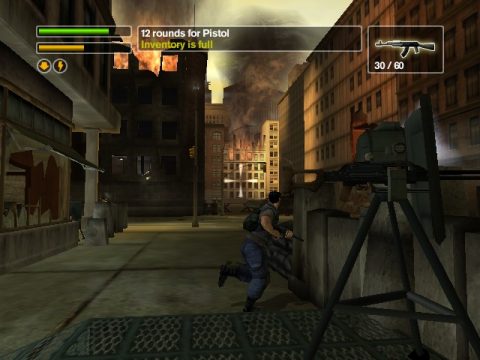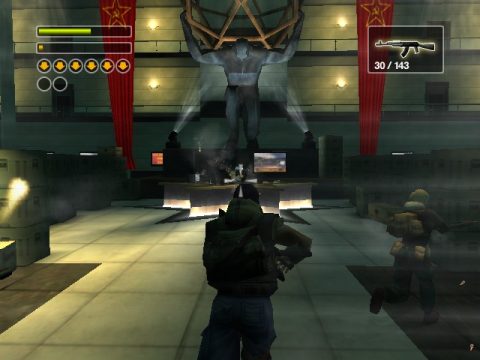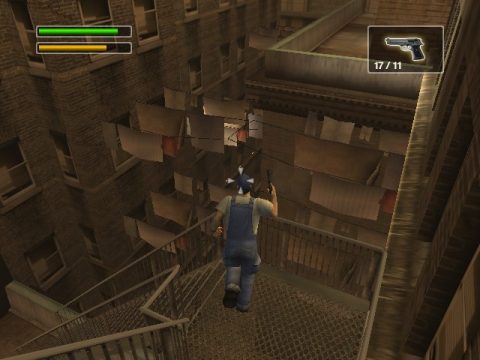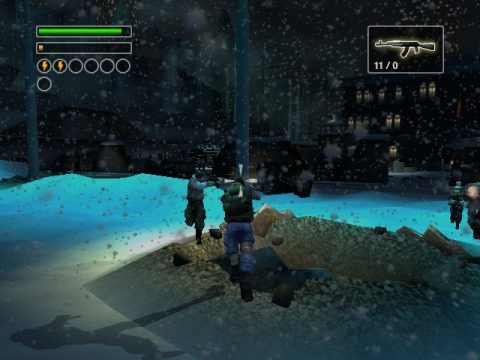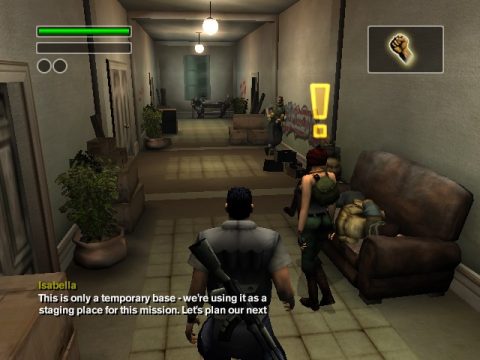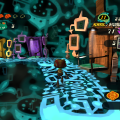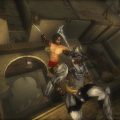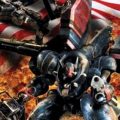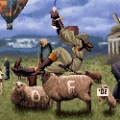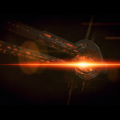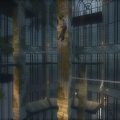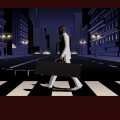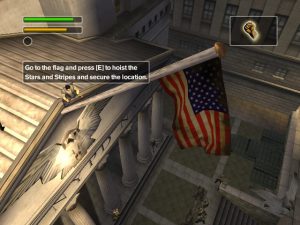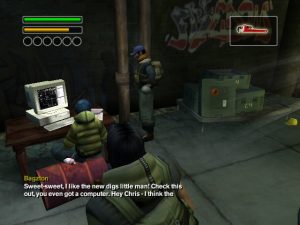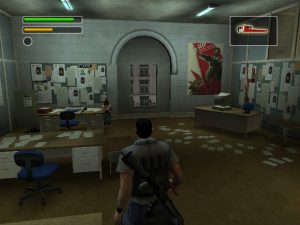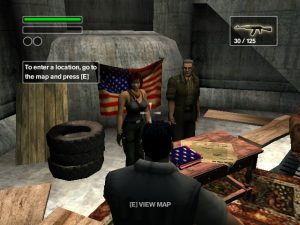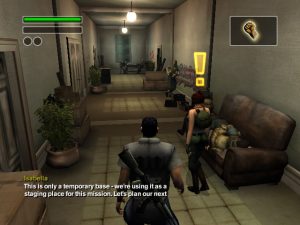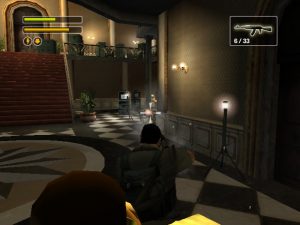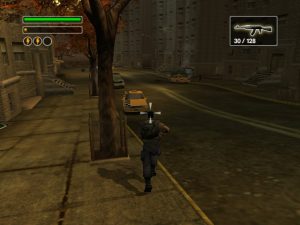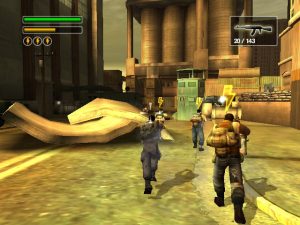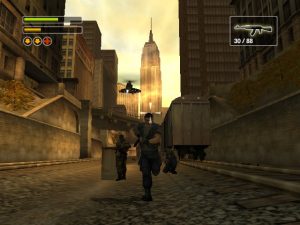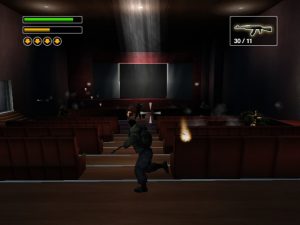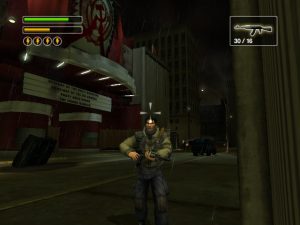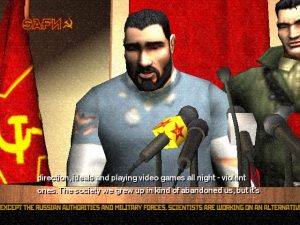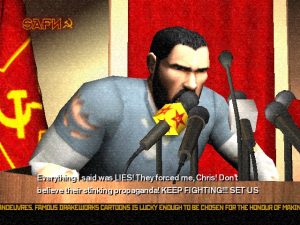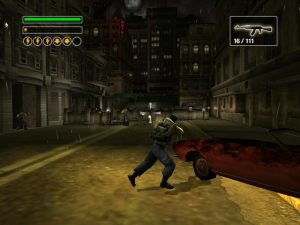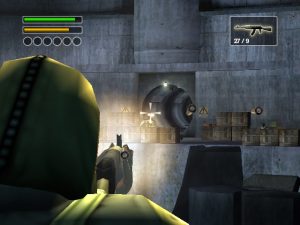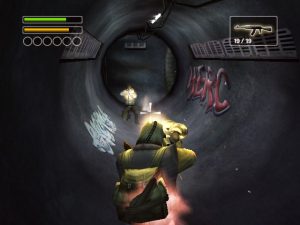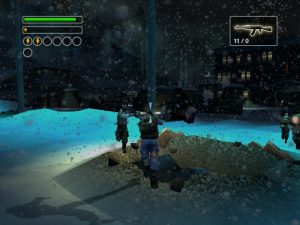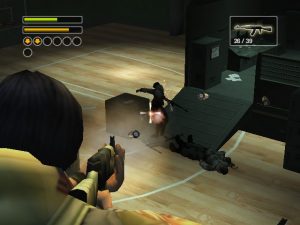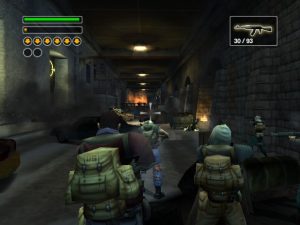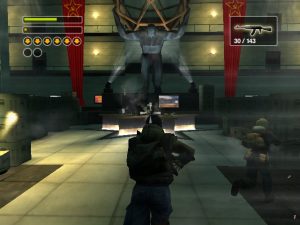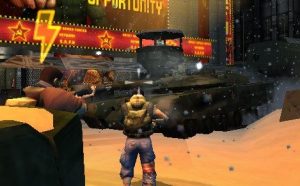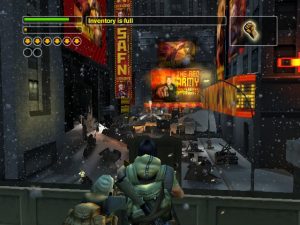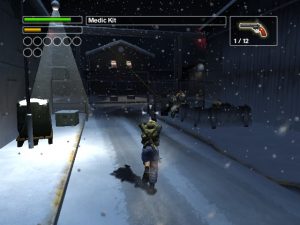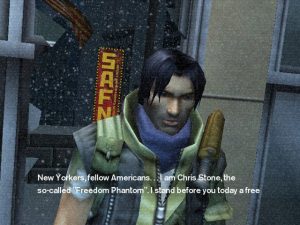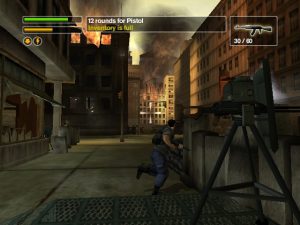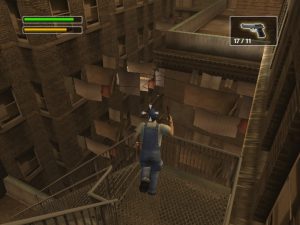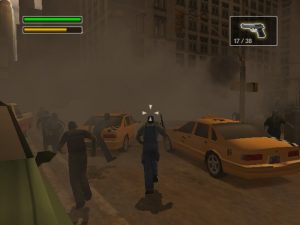Back when it was released in the holiday season of 2003, Freedom Fighters looked like it could be a bit of an embarrassment. The cover was almost hilariously over-American – rough sketches of military figures against a red, white and blue colored backdrop of New York City, who were fighting to save our dear precious nation from foreign invaders. By this time, the word “freedom” itself had become something of a loaded term, used to stir feelings of patriotism to excuse America’s more questionable actions. (This was also before the days of yearly military shooters like Call of Duty.)
So Freedom Fighters reeked of post 9/11 exploitation, trying to sell itself on the fear and paranoia instilled in our country by the terrorists. To the tin hat wearing crowd, it almost might seem like it was propaganda in video game form. It didn’t help that Electronic Arts’ name was on the box. Electronic Arts may once have been semi-reputable, and they still occasionally put out some okay games, but at the time they were a shameless-money-hungry-quality-be-damned corporation that would put out pandering shlock to fill our country’s needs to kill foreigners under the pretense of truth, justice, and the American way (for an honest to God example, see Fugitive Hunter, where you can kick Osama bin Laden in the balls, if you’d like.) Ironically, Freedom Fighters is far better than most other titles that were being published by Electronic Arts at the time.
Anyway, the game more or less tanked. If it had come out two years earlier, right after the attacks…well, it’d still seem skeezy, but at least it probably would’ve sold. But in those two years between 2001 and 2003, a good part of the nation was beginning to grow tired and bitter — comedians and rock bands built their acts on anti-Bush propaganda (see: the burgeoning popularity of The Daily Show, and eventually The Colbert Report, as well as Team America: World Police), and our small tiff with the French resulted in snarky college students in blue states across the nation sarcastically ordering “freedom fries” at their local diner, making one wonder if our grandparents were this cynical when sauerkraut was redubbed “liberty cabbage” during World War II. There were other reasons for its failure – it was a busy holiday season, and other critically acclaimed titles like Ubisoft’s Beyond Good and Evil also got left behind – but one can’t help to think that maybe Freedom Fighter‘s perceived political agenda may have put off the more liberal gamers.
On paper, the concept is this: the Soviets have invaded America and taken away our freedom, and must be repelled. Fine. Ever since Operation Desert Storm in the early 90s, American action movies have been posing Muslims as “the bad guys”, but in this situation, there’d be no way that any video game company would let that happen, especially with all of the heat that Grand Theft Auto had taken (you know, video games inspiring violence, etc etc), in addition to all of the real life violence against Muslim-Americans across the country. But what about the Soviets? The Soviets were our favorite bad guys in the 80s, but ever since the crumbling of the Berlin Wall, people hadn’t really taken them seriously (at least until it’d been revealed they meddled in the 2016 American Presidential election). The Cold War ended up sorta fizzling out, and our old enemies just kinda faded away into nothingness, making us wonder exactly why we were so afraid of to begin with. So why not use them as placeholders, instead of, say, Al-Qaeda? It must’ve made sense to the Electronics Arts exec that gave the greenlight to Freedom Fighters.
So it probably came as a disappointing surprise when Freedom Fighters was actually a biting criticism our government’s foreign policies, posing as an all-American patriotic shooter. In other words, it was incredibly sneaky.
In some ways, this almost makes sense. Freedom Fighters was created by IO Interactive, the same team behind the Hitman series. They’re based in Denmark. It might seem odd that a whole game about American patriotism would be designed by Europeans, but Grand Theft Auto – a series which channels American lifestyle and culture – is made by a team in Scotland. From the point of view of outsiders, they can poke some fun at our country, whereas our own citizens may not necessarily have that perspective.
Anyway, if you want, you can technically take Freedom Fighters at face value, which is probably what the publisher was hoping. When you start the game, you’re introduced to two Brooklyn plumbers named Christopher and Troy Stone. (Whether this is meant to parallel the Mario brothers or simply an excuse to bash people with a wrench, is not entirely clear.) When driving back to your apartment, the Commies stroll right on in, and they’re taking their invasion seriously. They’re not content to simply firebomb the city – they’ve brought in their tanks and helicopters and soldiers, and actively overthrowing the nation from the ground up. As Chris, you manage to escape, and someone end up leading rebel insurgence team intent on fighting against the Russian invaders. You run around parts of the city, kill some Commie bastards, and save the lives of the injured. You can interpret the whole thing as typical near-futuristic military Tom Clancy/Harry Turtledove-type drama, and it’d make sense.
There’s really a lot more beneath the surface though. The intro cutscene doesn’t go into details, but the manual fills you in on the backstory – apparently, the Soviets beat us to the punch and crushed the Nazis in World War II, allowing them to become a global superpower. They conquer the rest of the continent while America finds itself becoming increasingly irrelevant on the world stage. Sixty years later, the Soviets invade our country under the pretense of saving us. From what, exactly? The invaders claim to be saving us from an empty and vapid culture. More specifically, they’re saving us from democracy, having in their eyes failed compared to the glories of communism. But what’s their true motivation? Do we have precious natural resources that the Soviets desire? Are we covertly harboring weapons of mass destruction? Or, as the game seems to imply, are we simply the next stop on their way to world domination? We don’t know, and we’re never explicitly told. The role reversal parallels to America’s real life situation during Operation Iraqi Freedom – or hell, even Vietnam – aren’t exactly subtle, even they don’t entirely match one-for-one. Only the most ardent conspiracy theorist would suggest that modern day America is out to dominate the whole world, but the rest of the comparisons are pretty eerie.
In order to win most of the stages, all you need to do climb on the rooftop of the designated building, take down the Russian flag, and hoist the stars and stripes in its place, which immediately clears the level. It doesn’t matter whether you’re totally surrounded by bad guys and essentially cornered – apparently the sight of Old Glory has the power to cause all neighboring bad guys to simply throw down their arms and go home. It’s an unintended side effect of being a video game, but in the satirical context of Freedom Fighters, it’s really feels more like an exaggeration of the power of American ideals. Ultimately, it’s making something of a mockery of our perceived power, and it’s not exactly comforting.
In the early years of the 20th century, people were finding anti-Bush messages in all kinds of media, ranging from Star Wars to Harry Potter, even if they predated his presidency by decades. If any of that in Freedom Fighters was intentional, who knows. It’s certainly possible that IO Interactive was simply drawing upon modern day themes to present a more timeless story, a cautionary tale of a country with firm ideals but perhaps overwhelmed with arrogance. Even so, if interpreted as a political statement, Freedom Fighters can be a bit haunting. But if you remove these undertones, the whole thing might feel pretty silly, exceeding even the goofiest of action flicks. Even back in the 80s, where the Cold War produced singular action heroes that could do things that whole armies could not, without fear of deadly retaliation, no one really took them at face value – it was testosterone fueled escapism, and little more. Freedom Fighters gracefully sidesteps this entirely – it somehow manages to be both absurdly cheesy and grimly serious. And most of this can be credited to the impeccable atmosphere that the designers have created.
At the beginning of the game, right when the Soviets invade, the streets are overrun with chaos, clogged with disabled cars and panicked citizens scrambling for safety, the dust and dirt of collapsed building seeping through the air. There’s no question as to what the designers were trying to emulate – just trying to talking to anyone that was in Manhattan during the day of the terrorist attacks – but it’s even spookier once you get into the actual missions. The once bustling streets of the city are eerily empty, save for the handful of good guys and bad guys fighting it out. Familiarities like office buildings and movie theaters and schools have been converted into Soviet bases, complete with sandbags, gun towers, and machine gun emplacements, all being routinely patrolled by supply trucks. You plan all of your missions out of a makeshift base in the sewer system.
The earlier missions take place in the summer months, with the sun casting blinding lights on the muted, depressing browns of the city buildings. Later missions take place under the cover of night in autumn, with New York City’s sparse fauna turning colors amidst a never ending torrent of rain. The final levels occur during the bitterly cold northeast winter, as you wage war in the middle of calm snowstorms. Hundreds of video games have taken us through deserted towns and cities across the globe, but Freedom Fighters hits it far closer to home. It’s definitely preying on the anxieties of the American populace, but it’s hard to fault the designers for it when they’ve accomplished it so well.
A huge credit goes to composer Jesper Kyd (also of Hitman), who’s one of the best video game musicians working in the industry today. It channels 80s movies soundtracks but never ends up becoming cheesy. His fast paced techno beats are blended with both synth orchestration and the Slavic chants of the Hungarian Radio Choir. It conveys a sense of foreign dread, while managing to be both tense and exciting, enough to get your blood pumping when you’re fighting Ivan, and enough to creep you out in the calmer moments. The low key Rebel Base theme is the perfect backdrop to each mission briefly, the voices of your commanders echoing in the underground waterways of your makeshift base.
After every couple of stages, you’re treated to Soviet run propaganda newscasts, where enemy leaders are interviewed as celebrities and our hero is painted as the “Freedom Phantom”, one of the major threats to the peace that the Russians are attempting to bestow upon us. These do their job of moving the plot along, and while they’re relatively sparse, they’re quite effective. At one point, Chris’ captured brother is forced onto the airwaves to renounce the actions of his siblings. Before leaving his podium after his false speech, he breaks away and begs for Chris to keep fighting. The Soviets quickly pan to the sickle and hammer before cutting the signal. Right after, we learn that he was personally executed by the leader of the Soviet invaders. We never see it, it’s not part of a cutscene – it’s just spoken, in a very matter-of-fact manner, before the next mission briefing.
When fighting against the Soviets, most of the missions are pretty straightforward — you choose your stage, each having specific goals. There are usually secondary objectives, like blowing up bridges or rescuing hostages, which are all extremely important because they enhance your charisma, which is strangely denoted by a yellow bar beneath your life meter. The big gameplay hook of Freedom Fighters is that you can recruit practically any allied NPC and command them in battle. At the beginning, when you’re a new recruit, you can try to get people to join your squad and they pretty much just laugh in your face. As you earn more charisma, you can eventually recruit more people — up to a dozen in total.
The controls are generally pretty simple. Since this is made by the Hitman developers, and uses the same engine, the third person controls are practically identical. And just like Hitman, the movement is a bit awkward at first – up goes forward and down goes backward, but right and left will make your character strafe, as opposed to turn. Commanding your squad members is extraordinarily easy – you can yell at them to regroup, tell them to attack a specific target or tell them to defend a certain area. Just aim your crosshairs at their target, hit the command button, and they’ll do their duties. You either command them singularly or all at once, and since they all have the same capabilities, there’s no need to assign specific characters to specific tasks. It’s all mercifully easier than other tactical shooters like Rainbow Six, so pretty much anyone with shooter experience can wage war with relative ease.
In the PC versions, you can zoom in your view right the right mouse button, making it easier to aim and pick off targets. This is much more awkward to use in the consoles versions, so you have a pretty generous auto-aim to compensate. For the most part though, it’s much easier just to tell your soldiers to go off and kill someone in the distance, as opposed to dealing with them yourself. Your allies aren’t always extremely bright, but they are extraordinarily efficient, and can usually hunt down and kill enemy targets before you’ve even pinpointed their locations. Basically, this is the way the Halo games would work, if the Halo games actually gave you the freedom to command your own soldiers. Naturally, they’ll get themselves injured if you over rely on them, but any soldiers can be easily resurrected with a medkit. Through most missions, you’re playing a balancing act – save the health items for yourself or use them to keep the rest of the squad alive.
With all of these warriors at your disposal, Freedom Fighters needs to walk the fine line between pure action and pure tactical gameplay. Running through the streets blindly and shooting everything will get you killed pretty quickly, at least if you’re playing on the standard difficulty (and playing on anything less is a disservice to the game.) It forces you to explore ruined buildings or open alleyways to find some high ground to get past each enemy fortification. There are a couple areas where it’s to your advantage to simply sneak past enemy soldiers, but there are no omniscient transmissions cluing you in, nor any alarms that go off when you’re spotted. It’s all seamlessly integrated, and never actually mandatory, because running in with guns blazing is usually a valid option too, even though it’ll ultimately cost you health and ammo.
Koei’s Dynasty Warriors elicits a sheer visceral thrill from putting you in the shoes of a soldier that can effortless destroy hundreds upon hundreds of soldiers. Freedom Fighters elicits a similar power trip by putting you in charge of over a dozen soldiers that will gladly die for you with a single press of a button. It’s really a lot like the rush you get from a real time strategy game, when you point and click at whatever you want to die, and then you see some shit get wrecked up. Except in Freedom Fighters, you’re square in the middle of the action instead of acting as an all-seeing purveyor, observing and commanding safely from the skies above. Watching each firefight play out, your soldier ruthlessly hunting down your enemies while you yourself are dodging a maelstrom of bullets and scrambling for cover, all while barking out orders to your faithful compatriots, is a thing of glory.
Each set of stages are divided into chapters, and all stages within a chapter are linked to one another. For example, if you take out the helipad in one stage, then you don’t need to worry about being harassed by any helicopters in that particularly chapter. You can choose with order to conquer them in, and leave them to fight in another territory, if you want. This doesn’t play any huge part in the strategy, other than paying attention to where these obstacles are, but they’re a nice touch.
About halfway through the game, the standard mission structure are interrupted by two breakaway stages – a Hitman-style assassination attempt, and a standard action based level where you escape from the city sewers alone. While they’re undoubtedly there to make the game from becoming too repetitive, they’re poorly designed, and it goes to highlight that the strength of the gameplay is really the tactical aspects.
Freedom Fighters is not without other strange flaws. It uses a very out-of-place save mechanic, where you often need to go out of your way to find sewer manholes, which act as quick save points. It also suffers from an inverted difficulty curve. At the beginning, when you can only command a few soldiers, the going can get pretty rough. By the time you’ve amassed a sizable squadron at your command, the enemy forces never quite compensate for your enhanced strength, and it’s much easier to steamroll over them. It doesn’t help that the game is tragically short – if you burn through the game on the lower difficulty settings, you can beat it in about four or five hours. Naturally, it’ll take a bit longer at the harder difficulty levels, at least until you learn how to play the game properly.
Originally, the game was meant to be called “Freedom: The Battle for Liberty Island“, but was changed at the last minute. Possibly this is because Liberty Island isn’t actually featured at all – the final missions actually play out on Governor’s Island. There’s a half-completed stage available for play after completing the game at higher difficulty settings, which seems to imply that the game was rushed out the door. Given its holiday release and the monolithic publisher, this is quite likely.
Freedom Fighters may have failed in the marketplace, but it really shouldn’t have. It’s easy to pick up and learn the mechanics, but requires some effort before you can utilize them properly. As an action title…well, like most games, it could use a bit of polish, but it’s still incredibly fun. As a satire…well, it’s not exactly subtle or particularly insightful, considering the message is basically “The Good Guys aren’t as Good as they think they are”. But video games rarely address such issues, so the fact that it’s trying is notable enough. This, combined with the sterling atmosphere and fantastic soundtrack make for one of the great forgotten gems of the early 20th century.
There was actually a sequel scheduled, but later canned after the game’s failure to catch on the marketplace. IO Interactive’s subsequent game, Kane & Lynch: Dead Men, channeled some of the gameplay mechanics seen in Freedom Fighters, though little else.
Freedom Fighters can be played on the PC, PlayStation 2, Game Cube and Xbox. The PC version has the advantage of keyboard/mouse control, as well as higher frame rates, but the console versions are almost as good. It’s also one of the few Xbox titles that runs in high-def, if you have the set up for it. The console versions also have a throwaway multiplayer component, which was excluded from the PC version.
